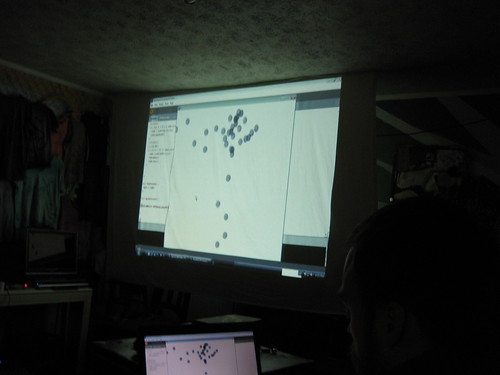Over the last few weeks I’ve seen a remarkable amount of news about cybernetics, and I haven’t been actively looking. The first piece was about a removable replacement eyeball installed in a blind man. The eye is not entirely functional, but does allow for partial (low resolution, spotty, grayscale) sight by interfacing an external camera to an artificial retina. Serious Brain-Computer interfaces like the synthetic retina have been appearing for about a decade, ranging from mostly useless, totally noninvasive devices like the various headband products sold as novelties to life-changing technology like the above.
A one-eyed filmmaker also had a bionic eye implanted. This one isn’t for the wearer’s benefit; it allows for wireless recording to provide a literal view through his eyes. The camera mechanism itself is internal and looks as natural as any prosthetic, allowing the wearer to interact as though he were not wielding a camera.
For the scifi dorks, in the latter episodes of Bayblon 5, G’kar had an eye which worked like the sum of the above; it was removable and wireless, but he was also able to see through it. It seems like that is the real yearning behind both projects; restorative, wireless, and shareable.
The next article I came across was in last month’s IEEE Spectrum, an article on the state of prosthetic arms (apologies if it tries to paywall you, for an organization for technology professionals, IEEE’s web presence is full of suck and fail), written by an engineer who lost his lower arm in Iraq, and was so disappointed by the selection of products on the market he joined the (DARPA-funded) efforts to develop next generation systems. He notes that the market for prosthetics is commercially unattractive, as there is only a minuscule need for any particular part, and suggests the remedy is open standards (for how the various prosthetic parts attach and communicate), and crossover technologies co-developed for mass market segments, such as interfaces with HCI (he says “video game controllers”, which I find horrifyingly disingenuous) and mechanical parts with robotics.
The last encounter was also about prosthetic limbs; (another) TED talk by Aimee Mullins a multi-talented woman who is missing her legs below the knee and uses a variety of prosthetics to adjust her appearance and abilities. The interesting part isn’t the particulars of the legs; it’s the way she and others perceive the legs. I’m going to go ahead and verbatim quote the end of Mullin’s talk, because it sums up the idea at least as eloquently as I could:
The conversation with society has changed profoundly in this last decade. It’s no longer a conversation about overcoming deficiency, it’s a conversation about augmentation; potential. A prosthetic limb doesn’t represent the need to replace loss anymore. It can stand as a symbol that the wearer has the power to create whatever it is that they want to create in that space. So, people that society once considered to be disabled can now become architects of new identities and indeed continue to change those identities by designing their bodies from a place of empowerment.
And, what is exciting to me, so much, right now, is that by combining cutting edge technology (robotics, bionics, etc.) with the age old poetry, we are moving closer to understanding our collective humanity. I think that if we want to discover the full potential of our humanity, we need to celebrate those heartbreaking strengths and those glorious disabilities that we all have. I think of Shakespeare’s Shylock: “If you prick us, do we not bleed, and if you tickle us, do we not laugh.”
What this all naturally leads to, at least for me, is my beliefs about the technological singularity. People usually consider that it will happen in one of two ways, artificial intelligence will surpass human capability (Strong AI), or people will be augmented beyond their current capabilities (Transhumanism, usually via technological augmentation (like this, another TED talk from people at the Media Lab, this one about awesome wearable augmented reality gear)). I believe firmly in the latter; we’re not going to build a better intelligence by trying, usually poorly, to replicate a human in devices which are poorly suited to the job. We can however build devices which are better suited to particular tasks than humans, and, if the interfaces between humans and these devices can be made adequately transparent, use them to augment human(?) capability far beyond current limitations.
My other big thought on the matter is that the singularity won’t be a quantum leap, and isn’t going to be something we know when happens; humans won’t be the top dog Monday night and superseded Tuesday morning; it will be something our augmented “superhuman” progeny look back and try to find a moment to assign as the turning point, just like every other incremental, iterative improvement in technology which has resulted in a leap in society as it permeated into our lives.






